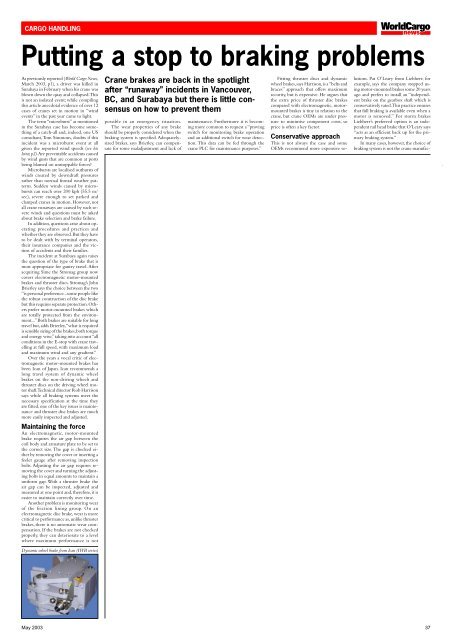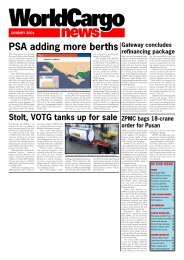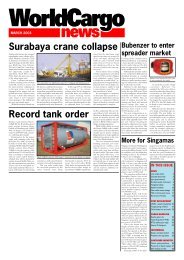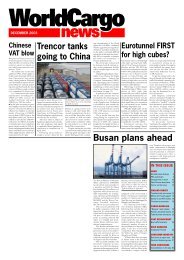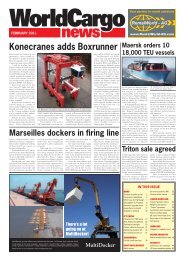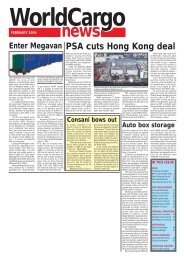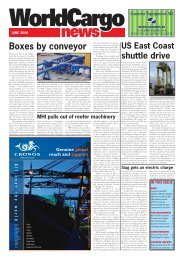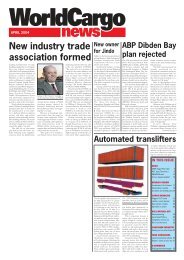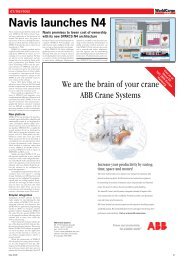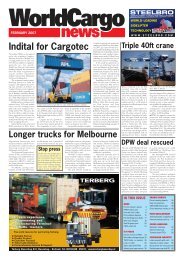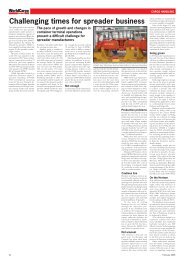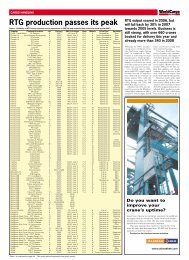Front Cover May - WorldCargo News Online
Front Cover May - WorldCargo News Online
Front Cover May - WorldCargo News Online
You also want an ePaper? Increase the reach of your titles
YUMPU automatically turns print PDFs into web optimized ePapers that Google loves.
CARGO HANDLING<br />
<strong>WorldCargo</strong><br />
news<br />
Putting a stop to braking problems<br />
As previously reported (World Cargo <strong>News</strong>,<br />
March 2003, p1), a driver was killed in<br />
Surabaya in February when his crane was<br />
blown down the quay and collapsed. This<br />
is not an isolated event; while compiling<br />
this article anecdotal evidence of over 12<br />
cases of cranes set in motion in ”wind<br />
events” in the past year came to light.<br />
The term “microburst” as mentioned<br />
in the Surabaya case has become something<br />
of a catch-all and, indeed, one US<br />
consultant, Tom Simmons, doubts if this<br />
incident was a microburst event at all<br />
given the reported wind speeds (see his<br />
letter, p2). Are preventable accidents caused<br />
by wind gusts that are common at ports<br />
being blamed on unstoppable forces?<br />
Microbursts are localised outbursts of<br />
winds created by downdraft pressures<br />
rather than normal frontal weather patterns.<br />
Sudden winds caused by microbursts<br />
can reach over 200 kph (55.5 m/<br />
sec), severe enough to set parked and<br />
clamped cranes in motion. However, not<br />
all crane runaways are caused by such severe<br />
winds and questions must be asked<br />
about brake selection and brake failure.<br />
In addition, questions arise about operating<br />
procedures and practices and<br />
whether they are observed. But they have<br />
to be dealt with by terminal operators,<br />
their insurance companies and the victims<br />
of accidents and their families.<br />
The incident at Surabaya again raises<br />
the question of the type of brake that is<br />
most appropriate for gantry travel. After<br />
acquiring Sime the Stromag group now<br />
covers electromagnetic motor-mounted<br />
brakes and thruster discs. Stromag’s John<br />
Brierley says the choice between the two<br />
“is personal preference...some people like<br />
the robust construction of the disc brake<br />
but this requires separate protection. Others<br />
prefer motor-mounted brakes which<br />
are totally protected from the environment...”<br />
Both brakes are suitable for long<br />
travel but, adds Brierley, “what is required<br />
is sensible sizing of the brakes, both torque<br />
and energy wise,” taking into account “all<br />
conditions in the E-stop with crane travelling<br />
at full speed, with maximum load<br />
and maximum wind and any gradient.”<br />
Over the years a vocal critic of electromagnetic<br />
motor-mounted brakes has<br />
been Ican of Japan. Ican recommends a<br />
long travel system of dynamic wheel<br />
brakes on the non-driving wheels and<br />
thruster discs on the driving wheel motor<br />
shaft. Technical director Rob Harrison<br />
says while all braking systems meet the<br />
necessary specification at the time they<br />
are fitted, one of the key issues is maintenance<br />
and thruster disc brakes are much<br />
more easily inspected and adjusted.<br />
Crane brakes are back in the spotlight<br />
after “runaway” incidents in Vancouver,<br />
BC, and Surabaya but there is little consensus<br />
on how to prevent them<br />
possible in an emergency situation.<br />
The wear properties of any brake<br />
should be properly considered when the<br />
braking system is specified. Adequatelysized<br />
brakes, says Brierley, can compensate<br />
for some maladjustment and lack of<br />
maintenance. Furthermore it is becoming<br />
more common to request a “proving<br />
switch for monitoring brake operation<br />
and an additional switch for wear detection.<br />
This data can be fed through the<br />
crane PLC for maintenance purposes.”<br />
Fitting thruster discs and dynamic<br />
wheel brakes, says Harrison, is a “belts and<br />
braces” approach that offers maximum<br />
security, but is expensive. He argues that<br />
the extra price of thruster disc brakes<br />
compared with electromagnetic, motormounted<br />
brakes is tiny in relation to the<br />
crane, but crane OEMs are under pressure<br />
to minimise component costs, so<br />
price is often a key factor.<br />
Conservative approach<br />
This is not always the case and some<br />
OEMs recommend more expensive solutions.<br />
Pat O’Leary from Liebherr, for<br />
example, says the company stopped using<br />
motor-mounted brakes some 20 years<br />
ago and prefers to install an “independent<br />
brake on the gearbox shaft which is<br />
conservatively rated. This practice ensures<br />
that full braking is available even when a<br />
motor is removed.” For storm brakes<br />
Liebherr’s preferred option is an independent<br />
rail head brake that O’Leary says<br />
“acts as an efficient back up for the primary<br />
braking system.”<br />
In many cases, however, the choice of<br />
braking system is not the crane manufac-<br />
Maintaining the force<br />
An electromagnetic, motor-mounted<br />
brake requires the air gap between the<br />
coil body and armature plate to be set to<br />
the correct size. The gap is checked either<br />
by removing the cover or inserting a<br />
feeler gauge after removing inspection<br />
bolts. Adjusting the air gap requires removing<br />
the cover and turning the adjusting<br />
bolts in equal amounts to maintain a<br />
uniform gap. With a thruster brake the<br />
air gap can be inspected, adjusted and<br />
measured at one point and, therefore, it is<br />
easier to maintain correctly over time.<br />
Another problem is monitoring wear<br />
of the friction lining group. On an<br />
electromagnetic disc brake, wear is more<br />
critical to performance as, unlike thruster<br />
brakes, there is no automatic wear compensation.<br />
If the brakes are not checked<br />
properly, they can deteriorate to a level<br />
where maximum performance is not<br />
Dynamic wheel brake from Ican (IWB series)<br />
<strong>May</strong> 2003 37


